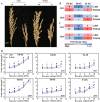The Inferior Grain Filling Initiation Promotes the Source Strength of Rice Leaves
- PMID: 37715876
- PMCID: PMC10505135
- DOI: 10.1186/s12284-023-00656-x
The Inferior Grain Filling Initiation Promotes the Source Strength of Rice Leaves
Abstract
Poor grain-filling initiation in inferior spikelets severely impedes rice yield improvement, while photo-assimilates from source leaves can greatly stimulate the initiation of inferior grain-filling (sink). To investigate the underlying mechanism of source-sink interaction, a two-year field experiment was conducted in 2019 and 2020 using two large-panicle rice cultivars (CJ03 and W1844). The treatments included intact panicles and partial spikelet removal. These two cultivars showed no significant difference in the number of spikelets per panicle. However, after removing spikelet, W1844 showed higher promotion on 1000-grain weight and seed-setting rate than CJ03, particularly for inferior spikelets. The reason was that the better sink activity of W1844 led to a more effective initiation of inferior grain-filling compared to CJ03. The inferior grain weight of CJ03 and W1844 did not show a significant increase until 8 days poster anthesis (DPA), which follows a similar pattern to the accumulation of photo-assimilates in leaves. After removing spikelets, the source leaves of W1844 exhibited lower photosynthetic inhibition compared to CJ03, as well as stronger metabolism and transport of photo-assimilates. Although T6P levels remained constant in both cultivars under same conditions, the source leaves of W1844 showed notable downregulation of SnRK1 activity and upregulation of phytohormones (such as abscisic acid, cytokinins, and auxin) after removing spikelets. Hence, the high sink strength of inferior spikelets plays a role in triggering the enhancement of source strength in rice leaves, thereby fulfilling grain-filling initiation demands.
Keywords: Phytohormone; Rice; Sink; Source; Sugar.
© 2023. Springer Science+Business Media, LLC, part of Springer Nature.
Conflict of interest statement
The authors declare no competing interest.
Figures






Similar articles
-
The Initiation of Inferior Grain Filling is Affected by Sugar Translocation Efficiency in Large Panicle Rice.Rice (N Y). 2019 Oct 15;12(1):75. doi: 10.1186/s12284-019-0333-7. Rice (N Y). 2019. PMID: 31617022 Free PMC article.
-
Sink Strength Promoting Remobilization of Non-Structural Carbohydrates by Activating Sugar Signaling in Rice Stem during Grain Filling.Int J Mol Sci. 2022 Apr 27;23(9):4864. doi: 10.3390/ijms23094864. Int J Mol Sci. 2022. PMID: 35563255 Free PMC article.
-
Efficiency of Sucrose to Starch Metabolism Is Related to the Initiation of Inferior Grain Filling in Large Panicle Rice.Front Plant Sci. 2021 Sep 13;12:732867. doi: 10.3389/fpls.2021.732867. eCollection 2021. Front Plant Sci. 2021. PMID: 34589107 Free PMC article.
-
Effect of Panicle Morphology on Grain Filling and Rice Yield: Genetic Control and Molecular Regulation.Front Genet. 2022 May 10;13:876198. doi: 10.3389/fgene.2022.876198. eCollection 2022. Front Genet. 2022. PMID: 35620460 Free PMC article. Review.
-
Biochemical and molecular processes contributing to grain filling and yield in rice.Plant Physiol Biochem. 2022 May 15;179:120-133. doi: 10.1016/j.plaphy.2022.03.010. Epub 2022 Mar 17. Plant Physiol Biochem. 2022. PMID: 35338943 Review.
Cited by
-
Application of slow-controlled release fertilizer coordinates the carbon flow in carbon-nitrogen metabolism to effect rice quality.BMC Plant Biol. 2024 Jun 29;24(1):621. doi: 10.1186/s12870-024-05309-9. BMC Plant Biol. 2024. PMID: 38951829 Free PMC article.
References
-
- Baena-González E, Hanson J. Shaping plant development through the SnRK1–TOR metabolic regulators. Curr Opin in Plant Biol. 2017;35:152–157. - PubMed
-
- Baena-González E, Rolland F, Thevelein JM, Sheen J. A central integrator of transcription networks in plant stress and energy signalling. Nature. 2007;448:938–942. - PubMed
-
- Baena-Gonzalez E, Lunn JE. SnRK1 and trehalose 6-phosphate—two ancient pathways converge to regulate plant metabolism and growth. Curr Opin Plant Biol. 2020;55:52–59. - PubMed
Grants and funding
- 31871573/National Natural Science Foundation of China
- 31871573/National Natural Science Foundation of China
- 31871573/National Natural Science Foundation of China
- 31871573/National Natural Science Foundation of China
- 31871573/National Natural Science Foundation of China
- 31871573/National Natural Science Foundation of China
- 31871573/National Natural Science Foundation of China
- 31871573/National Natural Science Foundation of China
- 31871573/National Natural Science Foundation of China
- 31871573/National Natural Science Foundation of China
- 31871573/National Natural Science Foundation of China
- 31871573/National Natural Science Foundation of China
- BE2021361/Jiangsu Provincial Key Research and Development Program
- BE2021361/Jiangsu Provincial Key Research and Development Program
- BE2021361/Jiangsu Provincial Key Research and Development Program
- BE2021361/Jiangsu Provincial Key Research and Development Program
- BE2021361/Jiangsu Provincial Key Research and Development Program
- BE2021361/Jiangsu Provincial Key Research and Development Program
- BE2021361/Jiangsu Provincial Key Research and Development Program
- BE2021361/Jiangsu Provincial Key Research and Development Program
- BE2021361/Jiangsu Provincial Key Research and Development Program
- BE2021361/Jiangsu Provincial Key Research and Development Program
- BE2021361/Jiangsu Provincial Key Research and Development Program
- BE2021361/Jiangsu Provincial Key Research and Development Program
LinkOut - more resources
Full Text Sources

